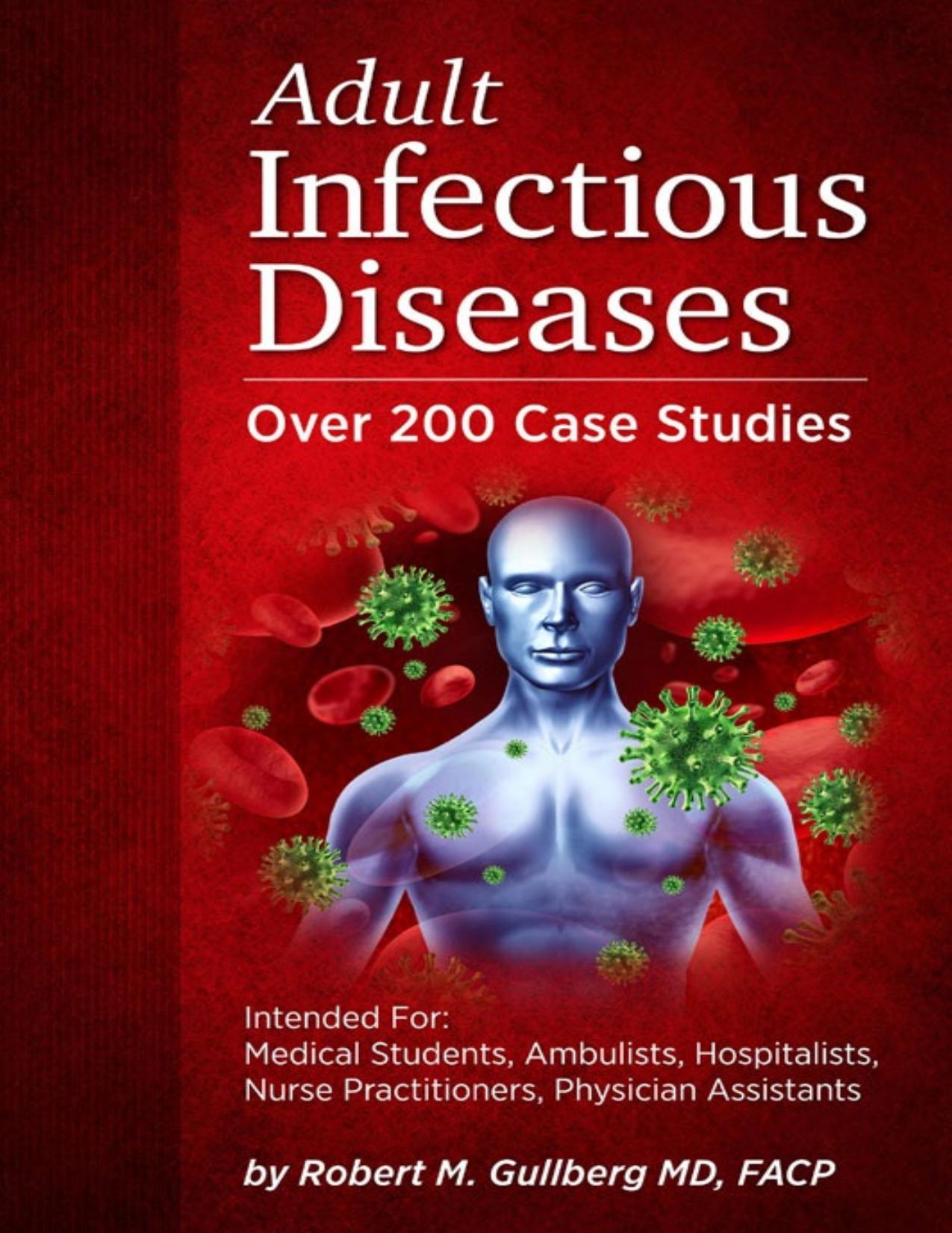Adult Infectious Diseases Over 200 Case Studies: Intended For: Medical Students, Ambulists, Hospitalists, Nurse Practitioners, Physician Assistants by Robert M. Gullberg

Author:Robert M. Gullberg [Gullberg, Robert M.]
Language: eng
Format: azw3, pdf
Tags: -
Publisher: BookBaby
Published: 2017-01-02T05:00:00+00:00
Answers:
97. D 98. B 99. E 100. D 101. C 102. E
Immunocompromised Patients
Introduction
Surface barriers- mechanical, chemical and biological- first line of defense for protection. Mechanical barriers include coughing, sneezing, the flushing effect of tears, urination, and the mucous effect of the GI tract to entangle bacteria. Chemical barriers protect us. The skin and respiratory tract secretes antimicrobial peptides called beta-defensins. Lysozyme and phospholipase A2 are secreted in saliva, tears, and breast milk. Vaginal secretions are acidic and this serves to protect from bacterial invasion. Gastric acid and proteases in the stomach serve as powerful chemical defenses. Semen contains defensins and zinc to kill would-be pathogens. “Normal flora” of the respiratory and GI tract biologically serve to protect us from pathogenic invasion. The Innate Immune System-Three Parts- Inflammation (1)- first response of the immune system to infection. Redness, swelling, heat and pain from increased blood flow to area of infection, produced by eicosanoids and prostaglandins released by damaged cells. Leukotrienes attract WBCs to the area of infecton. Cytokines include interleukins, chemokines, and interferons (which have anti-viral properties and shut down protein synthesis in a cell). Complement System (2)- a biochemical cascade that attacks a foreign cell. Contains over 20 different proteins that “complement” the immune system in killing pathogens. It is the major humoral immune component. Complement binds to antibodies that are attached to microbes, or directly to the microbe. This initiates a rapid killing response. A proteolytic cascade follows, and more opsonization of microbes and killing occurs. Phagocytosis (3)- phagocytes include PMNs, macrophages, dendritic cells. Cytokines “call” phagocytes to areas of infection. The pathogen is ingested by phagosome vesicle and then fuses with a lysosome. Dendritic cells are in contact with the external environment; found in the nose, on the skin, GI tract, and in the lungs.
The Adaptive Immune System- Lymphocytes-this immune system is antigen specific. Accordingly, immune responses are tailored depending on the pathogen. Thus, “memory T cells” are quick at recognizing previous pathogens. Lymphocytes:B-cells- responsible for the humoral immune system and the production of antibody. T-cells (3 basic kinds; killer, helper, and gamma/delta)- responsible for cell-mediated immunity. Both B cells and T cells carry receptor molecules that recognize specific targets on pathogens. Types of T-Lymphocytes-Helper T cells- 46% (have CD3, CD4 co-receptors) recognize antigens coupled to Class II MHC. They do no killing, but only direct the rest of the immune response. They are the “conductor of the symphony”. Helper T cells release cytokines that enhance the activity of killer T cells and cidal activity of macrophages. HIV infects these cells. Killer-cytotoxic T cells- 19% (have CD3, CD8 co-receptors) only recognize antigens coupled to Class 1 MHC (major histocompatibility complex). They kill host cells that are infected with viruses or are dysfunctional by releasing cytotoxins like perforins. Natural Killer T cells - 7% (have CD16, CD56 co-receptors) Gamma/delta T cells- 5% (a minor subset) recognize antigens not coupled to a MHC. B-Lymphocytes-important in the humoral, or immediate immune system. BCRs (B-cell Receptors) are on their cell surface. This allows specific binding to a protein antigen on a pathogen.
Download
Adult Infectious Diseases Over 200 Case Studies: Intended For: Medical Students, Ambulists, Hospitalists, Nurse Practitioners, Physician Assistants by Robert M. Gullberg.pdf
This site does not store any files on its server. We only index and link to content provided by other sites. Please contact the content providers to delete copyright contents if any and email us, we'll remove relevant links or contents immediately.
| Administration & Medicine Economics | Allied Health Professions |
| Basic Sciences | Dentistry |
| History | Medical Informatics |
| Medicine | Nursing |
| Pharmacology | Psychology |
| Research | Veterinary Medicine |
Periodization Training for Sports by Tudor Bompa(7918)
Why We Sleep: Unlocking the Power of Sleep and Dreams by Matthew Walker(6352)
Paper Towns by Green John(4797)
The Immortal Life of Henrietta Lacks by Rebecca Skloot(4257)
The Sports Rules Book by Human Kinetics(4078)
Dynamic Alignment Through Imagery by Eric Franklin(3919)
ACSM's Complete Guide to Fitness & Health by ACSM(3824)
Kaplan MCAT Organic Chemistry Review: Created for MCAT 2015 (Kaplan Test Prep) by Kaplan(3800)
Introduction to Kinesiology by Shirl J. Hoffman(3626)
Livewired by David Eagleman(3534)
The River of Consciousness by Oliver Sacks(3418)
The Death of the Heart by Elizabeth Bowen(3340)
Alchemy and Alchemists by C. J. S. Thompson(3294)
Descartes' Error by Antonio Damasio(3166)
Bad Pharma by Ben Goldacre(3095)
The Emperor of All Maladies: A Biography of Cancer by Siddhartha Mukherjee(2930)
The Gene: An Intimate History by Siddhartha Mukherjee(2927)
The Fate of Rome: Climate, Disease, and the End of an Empire (The Princeton History of the Ancient World) by Kyle Harper(2872)
Kaplan MCAT Behavioral Sciences Review: Created for MCAT 2015 (Kaplan Test Prep) by Kaplan(2815)
